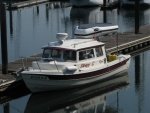So I will assume you also have a starting battery along with the proposed house bank. That really points toward a two bank charger for your needs although you can of course use a 3 bank and combine two sets of leads so long as the manual condones it.
You would have about 75-100 amp hours at most to use safely from your house bank of power. If you are charging from shore power at a marina, you would be plugged in for 10-16 hours giving you that much time for charging. In that situation, a 10amp charging curcuit may be enough to fully charge your depleted bank overnight depending on loads and whether those loads are coming from 12v or from 120 when plugged in.
If you are charging from your generator, you don't want to run it for very long so having a more powerful charger will help minimize that running time. I know some boaters will use one smaller built in charger for shore power charging and another portable unit for fast generator charging.
Think about what 12v loads you will be running overnight so you can factor that into your recovery needs when plugged into shore power. Also think about how low you will generally be comfortable running down your house bank. Some folks don't like to go below a specific voltage, and knowing that can really change your charging needs and minimize you charger purchase down to only what it needs to be.
As an example, I use a 3.5amp charger for our whole boat of 220ah house plus starting battery. We run the boat daily and usually for hours so that is actually our primary charging mode. 3.5amps overnight also adds up to 30-50amp hours of charge and that is more than we normally draw it down. We are running a small freezer now so our situation might change a bit, but the draw is low enough that a little solar could bring us even again.
I don't have experience with either of the two chargers you are looking at but did run another Promariner for a couple of years with no problems. I would pay attention to the charge cycles on each and consider the above factors in you choice of bank # and overall voltage. Temperature sensing chargers sometimes use separate sensors at the battery or sensors on the charger itself but the reality for us northwestern boaters, is that our temps are just low enough most of the time that charging temp affects us very little. The use of AGM/sealed batteries mitigates it further.
If you have a VSR battery connection in place between your house and start battery, you might even be able to use a single bank charger becuase it will share its charge with the other bank when above the set voltage.
The on demand feature of the Promariner would give you more amps to the house without wasting amps on the start battery and I personally like the charge profiles on these units more than the mastervolt. The mastervolt is a little yachty in design/features and that is not necessarily a good thing for all applications.
If those are your brands, I think this might be a good choice
http://www.amazon.com/ProMariner-ProSpo ... ort+20+plu
Or even this unit depending on your thoughts on the questions above.
http://www.amazon.com/ProMariner-43012- ... s=prosport
Greg

